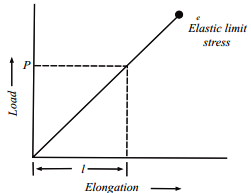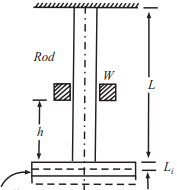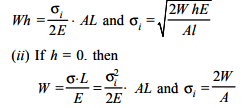When an external force acts on an elastic material and deforms it, internal resistance is developed in the material due to cohesion between the molecules comprising the material. The internal resistance does some work which is stored within the material as energy and this strain energy within elastic limit is known as resilience. What-ever energy is absorbed during loading, same energy is recovered during unloading and the material springs back to its original dimension. Machine members like helical, spiral and leaf springs possess this property of resilience.
A body may be subjected to following types of loads:
(1) Gradually applied load
(2) Suddenly applied load
(3) Falling or impact loads
(A) Gradually Applied Loads:
Load applied to a bar starts from zero and increases linearly until the bar is fully loaded. When the load is within elastic limit, the plot of load (stress) versus deformation (strain) is linear (Fig.). Work done = average load × deformation

= (1/2)P.δL = (1/2) (σA) × (σL/E)
= (1/2) (σ2 /E)(AL) = (σ2/2E) × Volume
Work done = (σ2/2E) × Volume
The strain energy U stored in the bar equals the work done and therefore
= (σ2/2E) × volume
The maximum strain energy absorbed by a body upto its elastic limit is termed as Proof Resilience and this proof resilience per unit volume is called Modulus of Resilience. Proof resilience = (σe 2/2E) × volume where se is the stress at elastic limit.
Modulus of resilience = σe 2/2E
(B) Suddenly Applied Load:
Load is applied suddenly and this *** constant throughout the process of deformation. Accordingly the plot between load and elongation will be parallel to x-axis.
Work done = area of shaded portion = P.δL = P(σsu.L/E)
The subscript su refers to suddenly applied load.
The work done equals the strain energy given by
(σsu2 /2E)(AL)
(σsu2 /2E)(AL) = p(σsu.L/E)
or, σsu= 2P/A = 2 × stress due to gradually applied load
Thus the instantaneous stress induced in a member due to suddenly applied load is twice that when the load is applied gradually.
(C) Impact Loads
Impact loading occurs when a weight is droped on a member from some height. The kinetic energy of the falling weight is utilized in deforming the member. Refer Fig, a rod of cross-sectional area A and length l is fixed at one end and has a collar at the outer end. A weight W, slides freely on the rod and is dropped on the collar through height. The falling weight causes impact load and that leads to extension δl i , and tensile stress σLi , (subscript i refers to impact load).

Now external work done = energy stored in the rod

Solution of this quadratic equation gives

Negative sign is inadmissible as the stress cannot be compressive when the bar gets elongated.

Following relations are worth noting:
(i) If δl i is neglected as compared to h, (if δL × 1000 < < < h), then

Note: Strain energy becomes smaller and smaller as cross sectional area of the bar is increased over more and more of its length.
Now strain energy for any types of load = U =1 σ2/2E. AL
where σ = P/A for qradually applied load
= 2 P/A for suddenly applied load
